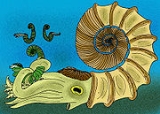
Aptian
Encyclopedia
The Aptian is an age in the geologic timescale or a stage in the stratigraphic column
. It is a subdivision of the Early or Lower Cretaceous
epoch
or series
and encompasses the time from 125.0 ± 1.0 Ma to 112.0 ± 1.0 Ma (million years ago), approximately. The Aptian succeeds the Barremian
and precedes the Albian
, all part of the Lower/Early Cretaceous.
The Aptian partly overlaps the upper part of the regionally used (in western Europe
) stage Urgonian.
in the Provence
region of France
. The original type locality
is in the vicinity of Apt. The Aptian was introduced in scientific literature by French palaeontologist Alcide d'Orbigny
in 1840.
The base of the Aptian stage is laid at magnetic anomaly M0r. A global reference profile for the base (a GSSP) had in 2009 not yet been appointed. The top of the Aptian (the base of the Albian) is at the first appearance of coccolithophore
species Praediscosphaera columnata in the stratigraphic record.
, the Aptian contains eight ammonite
biozone
s:
Sometimes the Aptian is subdivided in three substages or subages: Bedoulian (early or lower), Gargasian (middle) and Clansayesian (late or upper).
, Cedar Mountain Formation
, Cloverly Formation
, Elrhaz Formation
, Jiufotang Formation
, Little Atherfield
, Mazong Shan
, Potomac Formation
, Santana Formation
, Twin Mountains Formation
, Xinminbao Group
, Yixian Formation
†Ammonitida
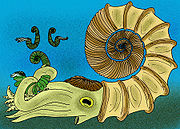
†Belemnitida
Fish
.; 1842: Paléontologie française: Terrains crétacés, vol. ii.
Stratigraphic column
A stratigraphic column is a representation used in geology and its subfield of stratigraphy to describe the vertical location of rock units in a particular area....
. It is a subdivision of the Early or Lower Cretaceous
Early Cretaceous
The Early Cretaceous or the Lower Cretaceous , is the earlier or lower of the two major divisions of the Cretaceous...
epoch
Epoch (geology)
An epoch is a subdivision of the geologic timescale based on rock layering. In order, the higher subdivisions are periods, eras and eons. We are currently living in the Holocene epoch...
or series
Series (stratigraphy)
Series are subdivisions of rock layers made based on the age of the rock and corresponding to the dating system unit called an epoch, both being formally defined international conventions of the geological timescale. A series is therefore a sequence of rock depositions defining a...
and encompasses the time from 125.0 ± 1.0 Ma to 112.0 ± 1.0 Ma (million years ago), approximately. The Aptian succeeds the Barremian
Barremian
The Barremian is an age in the geologic timescale between 130.0 ± 1.5 Ma and 125.0 ± 1.0 Ma). It is a subdivision of the Early Cretaceous epoch...
and precedes the Albian
Albian
The Albian is both an age of the geologic timescale and a stage in the stratigraphic column. It is the youngest or uppermost subdivision of the Early/Lower Cretaceous epoch/series. Its approximate time range is 112.0 ± 1.0 Ma to 99.6 ± 0.9 Ma...
, all part of the Lower/Early Cretaceous.
The Aptian partly overlaps the upper part of the regionally used (in western Europe
Western Europe
Western Europe is a loose term for the collection of countries in the western most region of the European continents, though this definition is context-dependent and carries cultural and political connotations. One definition describes Western Europe as a geographic entity—the region lying in the...
) stage Urgonian.
Stratigraphic definitions
The Aptian was named after the small city of AptApt, Vaucluse
Apt is a commune in the Vaucluse department in the Provence-Alpes-Côte d'Azur region in southeastern France.It lies on the left bank of the Calavon, east of Avignon...
in the Provence
Provence
Provence ; Provençal: Provença in classical norm or Prouvènço in Mistralian norm) is a region of south eastern France on the Mediterranean adjacent to Italy. It is part of the administrative région of Provence-Alpes-Côte d'Azur...
region of France
France
The French Republic , The French Republic , The French Republic , (commonly known as France , is a unitary semi-presidential republic in Western Europe with several overseas territories and islands located on other continents and in the Indian, Pacific, and Atlantic oceans. Metropolitan France...
. The original type locality
Type locality (geology)
Type locality , also called type area or type locale, is the where a particular rock type, stratigraphic unit, fossil or mineral species is first identified....
is in the vicinity of Apt. The Aptian was introduced in scientific literature by French palaeontologist Alcide d'Orbigny
Alcide d'Orbigny
Alcide Charles Victor Marie Dessalines d'Orbigny was a French naturalist who made major contributions in many areas, including zoology , palaeontology, geology, archaeology and anthropology....
in 1840.
The base of the Aptian stage is laid at magnetic anomaly M0r. A global reference profile for the base (a GSSP) had in 2009 not yet been appointed. The top of the Aptian (the base of the Albian) is at the first appearance of coccolithophore
Coccolithophore
Coccolithophores are single-celled algae, protists, and phytoplankton belonging to the division of haptophytes. They are distinguished by special calcium carbonate plates of uncertain function called coccoliths , which are important microfossils...
species Praediscosphaera columnata in the stratigraphic record.
Subdivision
In the Tethys domainTethys Ocean
The Tethys Ocean was an ocean that existed between the continents of Gondwana and Laurasia during the Mesozoic era before the opening of the Indian Ocean.-Modern theory:...
, the Aptian contains eight ammonite
Ammonite
Ammonite, as a zoological or paleontological term, refers to any member of the Ammonoidea an extinct subclass within the Molluscan class Cephalopoda which are more closely related to living coleoids Ammonite, as a zoological or paleontological term, refers to any member of the Ammonoidea an extinct...
biozone
Biozone
Biostratigraphic units or Biozones are intervals of geological strata that are defined on the basis of their characteristic fossil taxa....
s:
- zone of Hypacanthoplites jacobi
- zone of Nolaniceras nolani
- zone of Parahoplites melchioris
- zone of Epicheloniceras subnodosocostatum
- zone of Duffrenoyia furcata
- zone of Deshayesites deshayesi
- zone of Deshayesites weissi
- zone of Deshayesites oglanlensis
Sometimes the Aptian is subdivided in three substages or subages: Bedoulian (early or lower), Gargasian (middle) and Clansayesian (late or upper).
Lithostratigraphic units
Antlers FormationAntlers Formation
The Antlers Formation occurs as a band of strata from Arkansas through southern Oklahoma into northeastern Texas. It consists of 150 m of silty to sandy mudstones, fine- to coarse grained sandstones that are poorly to moderately sorted and cemented with clay or calcium carbonate...
, Cedar Mountain Formation
Cedar Mountain Formation
The Cedar Mountain Formation is the name given to distinctive sedimentary rocks in eastern Utah that occur between the underlying Morrison Formation and overlying Naturita Formation . It is composed of non-marine sediments, that is, sediments deposited in rivers, lakes and on flood plains...
, Cloverly Formation
Cloverly Formation
The Cloverly Formation are Lower Cretaceous strata located in Montana and Wyoming, in the western United States. The term now includes strata that had formerly been called the Dakota Formation in central and southern Wyoming.-Members:...
, Elrhaz Formation
Elrhaz Formation
The Elrhaz Formation is a geological formation in Niger whose strata date back to the Early Cretaceous...
, Jiufotang Formation
Jiufotang Formation
The Jiufotang Formation is an Early Cretaceous geological formation in Chaoyang, Liaoning which has yielded fossils of feathered dinosaurs, primitive birds, pterosaurs, and other organisms. . It is a member of the Jehol group. The exact age of the Jiufotang has been debated for years, with...
, Little Atherfield
Little Atherfield
Little Atherfield is a village on the Isle of Wight. It is near the coast in the Back of the Wight. The Isle of Wight is situated off the south coast of England.-History:...
, Mazong Shan
Mazong Shan
The Mazong Shan is a minor mountain range of northern Gansu, between the Altay range to the north and the Qilian range to the south. The Mazong Shan peak rises to 2584 m....
, Potomac Formation
Potomac Formation
The Potomac Formation consists of Lower Cretaceous to Upper Cretaceous strata located in Delaware, Maryland, and New Jersey, in the eastern United States.Flora found include large cycads....
, Santana Formation
Santana Formation
The Santana Formation is a geologic Lagerstätte in northeastern Brazil's Araripe Basin where the states of Pernambuco, Piauí and Ceará come together. The geological formation, named after the village of Santana do Cariri, lies at the base of the Araripe Plateau...
, Twin Mountains Formation
Twin Mountains Formation
The Twin Mountains Formation, also known as the Twin Mountain Formation, is a sedimentary rock formation, within the Trinity Group, found in Texas of the United States of America. It is a terrestrial formation of Aptian age , and is notable for its dinosaur fossils...
, Xinminbao Group
Xinminbao Group
The Xinminbao Group is a group of geological formations in north central China. They occur across a large depression between the Altai mountains of Mongolia to the north and the Qilian mountains of the Qinghai Plateau to the south, in the Gonpoquan and Suanjingze basins, and also in the...
, Yixian Formation
Yixian Formation
The Yixian Formation is a geological formation in Jinzhou, Liaoning, People's Republic of China, that spans 11 million years during the early Cretaceous period...
†AmmonitidaAmmonitidaThe Ammonitida is an order of more highly evolved ammonoid cephalopods from the Jurassic and Cretaceous time periods, commonly with intricate ammonitic sutures....
- PictetiaPictetiaPictetia is a genus of flowering plants in the legume family, Fabaceae. It belongs to the sub family Faboideae....
- Eogaudryceras
- Georgioceras
- Lithancylus
- Salfeldiella
- ZuercherellaZuercherellaZuercherella is an extinct genus of cephalopod belonging to the Ammonite subclass....
- Lower
- Eotetragonites
- Pseudosaynella
- Roloboceras
- Helicancylus
- Procheloniceras
- Prodeshayesites
- ShastocerasShastocerasShastoceras is an extinct genus of ammonite cephalopod found in Lower Aptian sediments in Northern California.It, like its close relative, Annuloceras, is a heteromorph ammonite that strongly resembles Macroscaphites....
- AmmonitocerasAmmonitocerasAmmonitoceras is an extinct genus of cephalopod belonging to the Ammonite subclass.Type-species : Ammonitoceras ucetiae DUMAS 1876...
- AustralicerasAustralicerasAustraliceras is an extinct genus of cephalopod belonging to the Ammonite subclass....
- Cheloniceras
- Cicatrites
- Colombiceras
- Dufrenoya
- Melchiorites
- Parahoplites

- Upper
- Hypacanthoplites
- Sinzovia
- Trochleiceras
- Mathoceratites
- Metahamites
- Neosilesites
- Protanisoceras
- AmmonoceratitesAmmonoceratitesAmmonoceratites is an extinct genus of cephalopod belonging to the Ammonite subclass....
- BeudanticerasBeudanticerasBeudanticeras is an extinct cephalopod genus from the Cretaceous period belonging to the ammonoid subclass and included in the family Desmoceratidae....
- Gyaloceras
- Hulenites
- Knemiceras
- UhligellaUhligellaUhligella is an extinct cephalopod genus from the Early Cretaceous belonging to the ammonoid subclass and included in the Desmoceratidae....
- AcanthohoplitesAcanthohoplitesAcanthohoplites is a Lower Cretaceous ammonite in the family Douvilleiceratidae that has a strongly ribbed shell and ammonitic suture.Early whorls are coronate, which later become round, then oval in section. Primary ribs may have swellings at the umbilicus or are without. In early stages primary...
- AcanthoplitesAcanthoplitesAcanthoplites is an extinct genus of cephalopod belonging to the Ammonite subclass. Like many other Ammonites, Acanthoplites was a marine nektonic carnivore.-Fossil Record:...
- ArgonauticerasArgonauticerasArgonauticeras is an extinct genus of cephalopod belonging to the Ammonite subclass....
- Burckhardites
- Cloioceras
- Diadochoceras
- Diodochoceras
- Eodouvilleiceras
- Epancyloceras
- Epicheloniceras
- Gargasiceras
- Jauberticeras
- Kazanskyella
- Mathoceras
- Megatyloceras
- Miyakoceras
- Nodosohoplites
- Nolaniceras
- Protacanthoplites
- Somalites
- Theganoceras
- TropaeumTropaeumTropaeum is an extinct genus of ammonite cephalopod found throughout the oceans of the world during the Early Cretaceous. As with many other members of the family Ancyloceratidae, there was a trend among species within this genus to uncoil somewhat, in a very similar manner in the genus...
- Gabbioceras
- Tetragonites
- Desmoceras
- HamitesHamitesHamites is a genus of heteromorph ammonite that evolved late in the Aptian stage of the Early Cretaceous and lasted into the Cenomanian stage of the Late Cretaceous. The genus is almost certainly paraphyletic but remains in wide use as a "catch all" for heteromorph ammonites of the superfamily...
†BelemnitidaBelemnitidaBelemnitida is an extinct order of cephalopods which existed during the Mesozoic era, from the Hettangian age of the Lower Jurassic to the Maastrichtian age of the Upper Cretaceous.-Description:...
- VectibelusVectibelusVectibelus is a genus of belemnite, an extinct group of cephalopods....
- ConoteuthisConoteuthisConoteuthis is a genus of belemnite, an extinct group of cephalopods....
- Lower
- TetrabelusTetrabelusTetrabelus is a genus of belemnite, an extinct group of cephalopods....
- PeratobelusPeratobelusPeratobelus is a genus of belemnite, an extinct group of cephalopods....
- ParahibolitesParahibolitesParahibolites is a genus of belemnite, an extinct group of cephalopods....
- Tetrabelus
†Ankylosaurs
| †Ankylosauria Ankylosauria Ankylosauria is a group of herbivorous dinosaurs of the order Ornithischia. It includes the great majority of dinosaurs with armor in the form of bony osteoderms. Ankylosaurs were bulky quadrupeds, with short, powerful limbs. They are first known to have appeared in the early Jurassic Period of... of the Aptian |
||||
|---|---|---|---|---|
| Taxa | Presence | Location | Description | Images |
|
Cedar Mountain Formation Cedar Mountain Formation The Cedar Mountain Formation is the name given to distinctive sedimentary rocks in eastern Utah that occur between the underlying Morrison Formation and overlying Naturita Formation . It is composed of non-marine sediments, that is, sediments deposited in rivers, lakes and on flood plains... , Utah, USA |
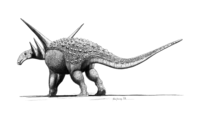 |
||
|
Ulansuhai Formation Ulansuhai Formation The Ulansuhai Formation is a geological formation in Inner Mongolia, north China. Dinosaur remains are among the fossils that have been recovered from the formation.... , Inner Mongolia, China |
|||
|
Liaoningosaurus Liaoningosaurus is a very unusual ankylosaur from the Lower Cretaceous. The holotype IVPP V12560 , an essentially complete juvenile skeleton compressed on a slab, was collected from the Yixian Formation of Liaoxi, Yixian County, Liaoning Province, People's Republic of China.The type species... |
Yixian Formation Yixian Formation The Yixian Formation is a geological formation in Jinzhou, Liaoning, People's Republic of China, that spans 11 million years during the early Cretaceous period... , Liaoning, China |
Nodosaurid with ventral armor plating | ||
|
Minmi (dinosaur) Minmi, named after Minmi Crossing, Australia , is a genus of small ankylosaurian dinosaur that lived during the early Cretaceous Period, about 119 to 113 million years ago. The type species, M. paravertebra, was described by Ralph Molnar in 1980... |
Bungil Formation Bungil Formation The Bungil Formation is a geological formation in Australia whose strata date back to the Early Cretaceous. Dinosaur remains are among the fossils that have been recovered from the formation.-Vertebrate paleofauna:-References:... , Queensland, Australia |
Small (1 meter long) primitive ankylosaur | ||
|
Sauropelta Sauropelta is a genus of nodosaurid dinosaur that existed in the Early Cretaceous Period of North America. One species has been named although others may have existed. Anatomically, Sauropelta is one of the most well-understood nodosaurids, with fossilized remains recovered in the U.S. states of... |
Aptian to Albian Albian The Albian is both an age of the geologic timescale and a stage in the stratigraphic column. It is the youngest or uppermost subdivision of the Early/Lower Cretaceous epoch/series. Its approximate time range is 112.0 ± 1.0 Ma to 99.6 ± 0.9 Ma... |
Cloverly Formation Cloverly Formation The Cloverly Formation are Lower Cretaceous strata located in Montana and Wyoming, in the western United States. The term now includes strata that had formerly been called the Dakota Formation in central and southern Wyoming.-Members:... , Wyoming, Montana, Utah, USA |
A medium-sized nodosaurid, measuring about 5 meters (16.5 ft) long, Sauropelta had a distinctively long tail which made up about half of its body length. Its neck and back were protected by an extensive bony body armor including characteristically large spines | |
|
Shamosaurus Shamosaurus is an extinct genus of basal ankylosaurid ankylosaur from Early Cretaceous deposits of Höövör, Mongolia. Shamosaurus is known from the holotype PIN N 3779/2 complete skull and jaw and the paratypes include partial skeleton remains and an armor. It was collected from the... |
Mongolia | Ankylosaurid | ||
Birds
- Boluochia zhengi
- Chaoyangia beishanensis
- Confuciusornis sanctus
- Cuspirostrisornis houi
- Jeholornis prima
- Jixiangornis orientalis
- Largirostrornis sexdentoris
- Longchengornis sanyanensis
- Longipteryx chaoyangensis
- Sapeornis chaoyangensis
- Sinornis santensis/Cathayornis yandica
- Songlingornis linghensis
- Yanornis martini
- Yixianornis grabaui
†Ceratopsians
| †Ceratopsia Ceratopsia Ceratopsia or Ceratopia is a group of herbivorous, beaked dinosaurs which thrived in what are now North America, Europe, and Asia, during the Cretaceous Period, although ancestral forms lived earlier, in the Jurassic. The earliest known ceratopsian, Yinlong downsi, lived between 161.2 and 155.7... of the Aptian |
||||
|---|---|---|---|---|
| Taxa | Presence | Location | Description | Images |
|
Mazong Shan Mazong Shan The Mazong Shan is a minor mountain range of northern Gansu, between the Altay range to the north and the Qilian range to the south. The Mazong Shan peak rises to 2584 m.... , Gansu, China |
A basal neoceratopsian, appears to have been bipedal and quite small (about 1 meter long) with a comparatively large head. Unlike many later ceratopsians it doesn't have any horns and has only a small bony frill projecting from the back of its head. |
  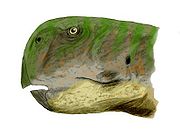 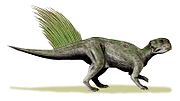 |
|
|
Xinminbao Group Xinminbao Group The Xinminbao Group is a group of geological formations in north central China. They occur across a large depression between the Altai mountains of Mongolia to the north and the Qilian mountains of the Qinghai Plateau to the south, in the Gonpoquan and Suanjingze basins, and also in the... , Gansu, China |
Basal neoceratopsian | ||
|
Psittacosaurus Psittacosaurus is a genus of psittacosaurid ceratopsian dinosaur from the Early Cretaceous Period of what is now Asia, about 130 to 100 million years ago. It is notable for being the most species-rich dinosaur genus... |
China, Mongolia, Russia | Psittacosaurid Ceratopsian | ||
|
Serendipaceratops Serendipaceratops is a dubious genus of ornithischian dinosaur from the early Cretaceous Period of Australia.The type species, S. arthurcclarkei, was named after Arthur C... |
Victoria, Australia | 2 meters long early ceratopsian | ||
†Choristoderans
| †Choristodera Choristodera Choristodera is an order of semi-aquatic diapsid reptiles which ranged from the Middle Jurassic, or possibly Late Triassic, to at least the early Miocene. Choristoderes have been found in North America, Asia, and Europe. The most common fossils are typically found from the Late Cretaceous to the... ns of the Aptian |
||||
|---|---|---|---|---|
| Taxa | Presence | Description | Images | |
Genus:
|
|
|||
Genus:
|
||||
FishFishFish are a paraphyletic group of organisms that consist of all gill-bearing aquatic vertebrate animals that lack limbs with digits. Included in this definition are the living hagfish, lampreys, and cartilaginous and bony fish, as well as various extinct related groups...
- HybodusHybodusHybodus is an extinct genus of once-common, widespread and long lived sharks, first appearing towards the end of the Permian period, and disappearing at the beginning of the Cretaceous. During the Triassic, Jurassic, and Cretaceous periods the hybodonts were especially successful and could be...
- Jinanichthys longicephalus
- Lycoptera davidi
- Lycoptera muroii
- Peipiaosteus pani
- Protosephurus liui
- Sinamia zdanskyi
Mammalia
| Mammals of the Hauterivian | ||||
|---|---|---|---|---|
| Taxa | Presence | Location | Description | Images |
|
several species from Hauterivian to Albian Albian The Albian is both an age of the geologic timescale and a stage in the stratigraphic column. It is the youngest or uppermost subdivision of the Early/Lower Cretaceous epoch/series. Its approximate time range is 112.0 ± 1.0 Ma to 99.6 ± 0.9 Ma... |
Spain, Mongolia |  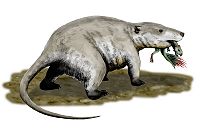  |
|
|
Yixian Formation Yixian Formation The Yixian Formation is a geological formation in Jinzhou, Liaoning, People's Republic of China, that spans 11 million years during the early Cretaceous period... , Liaoning, China |
A long-tailed, nocturnal tetrapod (with prensile fingers and toes) which hunted insects, its food, during the night | ||
|
Repenomamus Repenomamus is the largest mammal known from the Cretaceous period of Manchuria, and it is the mammal for which there is the best evidence that it fed on dinosaurs. It is not possible to determine if Repenomamus actively hunted live dinosaurs or scavenged dead dinosaurs.-Paleobiology:Repenomamus... |
Yixian Formation Yixian Formation The Yixian Formation is a geological formation in Jinzhou, Liaoning, People's Republic of China, that spans 11 million years during the early Cretaceous period... , Liaoning, China |
The largest mammal known from the Cretaceous period of the Mesozoic, and the one for which there is the best evidence that it fed on dinosaurs. | ||
|
Teinolophos Teinolophos trusleri was a prehistoric species of monotreme, or egg-laying mammal. It is known from a lower jawbone found in Flat Rocks, Victoria, Australia. It lived during the Aptian age of the Lower Cretaceous. It is the earliest known relative of the Platypus.The species name honours the... |
Flat Rocks, Victoria, Australia | The earliest known monotreme. | ||
|
Yanoconodon Yanoconodon is a monotypic genus of extinct early mammal whose representative species Yanoconodon allini lived 125 million years ago during the Mesozoic in what is now China. It is considered to be a transitional fossil due to the formation of its middle ear, which is a cross between those of... |
Yixian Formation Yixian Formation The Yixian Formation is a geological formation in Jinzhou, Liaoning, People's Republic of China, that spans 11 million years during the early Cretaceous period... , Hebei, China |
A small mammal, barely 13 centimetres (5 inches) long. It was lightly built and fed on insects, worms and other invertebrates, probably hunting at night. Like most early mammals, Yanoconodon had short, sprawling legs and claws that were most likely used for burrowing underground or digging | ||
†Ornithopods
| †Ornithopoda of the Aptian | ||||
|---|---|---|---|---|
| Taxa | Presence | Location | Description | Images |
|
Aptian/Albian Albian The Albian is both an age of the geologic timescale and a stage in the stratigraphic column. It is the youngest or uppermost subdivision of the Early/Lower Cretaceous epoch/series. Its approximate time range is 112.0 ± 1.0 Ma to 99.6 ± 0.9 Ma... |
Dinosaur Cove Dinosaur Cove Not to be confused with the children's book series of the same name.Dinosaur Cove in Victoria, Australia is a fossil bearing site in south-east of the continent where the Otway Ranges meet the sea to the west of Cape Otway, adjacent to Great Otway National Park .The inaccessible ocean-front cliffs... , Victoria, Australia |
2-3 meters long hypsilophodont |
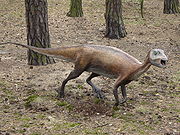  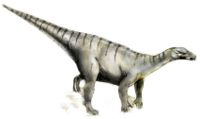 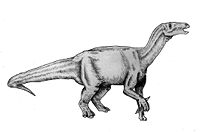 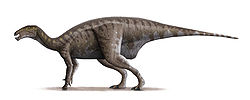 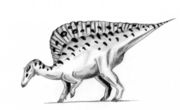 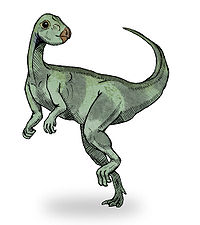   |
|
Quantou Formation Quantou Formation The Quantou Formation is a Mesozoic geologic formation. Dinosaur remains are among the fossils that have been recovered from the formation, although none have yet been referred to a specific genus.-See also:* List of dinosaur-bearing rock formations... , Jilin, China |
As a small basal ornithopod, Changchunsaurus would have been a swift bipedal herbivore, feeding close to the ground. | ||
|
Dollodon Dollodon is a genus of ornithopod dinosaur that lived in the Barremian and possibly the early Aptian ages of the Early Cretaceous Period of Europe. Its remains are known from Belgium , England and possibly Germany... |
Barremian Barremian The Barremian is an age in the geologic timescale between 130.0 ± 1.5 Ma and 125.0 ± 1.0 Ma). It is a subdivision of the Early Cretaceous epoch... -?Aptian |
Bernissart Bernissart Bernissart is a Walloon municipality located in the Belgian province of Hainaut. On January 1, 2006 Bernissart had a total population of 11,458. The total area is 43.42 km², which gives a population density of 264 inhabitants per km².... , Belgium; ?England; ?Germany |
A lightly constructed iguanodont, about 6 meters long (20 ft), estimated to weigh about 1 ton | |
|
Equijubus Equijubus, meaning "horse mane" after the area in which it was found, is a genus of herbivorous hadrosauroid dinosaur from the Early Cretaceous of northwestern China.-Discovery and naming:... |
Mazong Shan Mazong Shan The Mazong Shan is a minor mountain range of northern Gansu, between the Altay range to the north and the Qilian range to the south. The Mazong Shan peak rises to 2584 m.... , Gansu, China |
Primitive hadrosaur or iguanodont | ||
|
Iguanodon Iguanodon is a genus of ornithopod dinosaur that lived roughly halfway between the first of the swift bipedal hypsilophodontids and the ornithopods' culmination in the duck-billed dinosaurs... |
Asia, Europe, North America | Worldwide distributed, type genus of the Iguanodontia. 10 meters long | ||
|
Lurdusaurus Lurdusaurus is a genus of large ornithopod dinosaur which lived in the Aptian stage of the Early Cretaceous, sometime between 121 to 112 million years ago.-Discovery and naming:... |
Niger | 9 meters long heavily built Iguanodont | ||
|
Mantellisaurus Mantellisaurus is a genus of dinosaur formerly known as Iguanodon atherfieldensis. The new genus was erected by Gregory Paul in 2007. According to Paul, it is more lightly built than Iguanodon and more closely related to Ouranosaurus, making Iguanodon in its traditional sense paraphyletic. It is... |
Atherfield, England, UK | formerly known as Iguanodon atherfieldensis | ||
|
Ouranosaurus Ouranosaurus is an unusual genus of herbivorous iguanodont dinosaur that lived during the early Cretaceous about 110 million years ago in what is now Africa. Ouranosaurus measured about seven to eight meters long... |
Echkar Formation, Niger | 7 meters long hadrosauroid, possibly with a sail on the back | ||
|
Planicoxa Planicoxa is a genus of advanced iguanodontian dinosaur from the Early Cretaceous of North America. It is known from the partial skeletons of several individual specimens. Its fossils were discovered in Utah and South Dakota, United States.... |
Cedar Mountain Formation Cedar Mountain Formation The Cedar Mountain Formation is the name given to distinctive sedimentary rocks in eastern Utah that occur between the underlying Morrison Formation and overlying Naturita Formation . It is composed of non-marine sediments, that is, sediments deposited in rivers, lakes and on flood plains... , Utah; Lakota Formation Lakota Formation The Lakota Formation is a sequence of rocks from the Barremian epoch from Western North America. Located in South Dakota, the name is derived from the Lakota Native American tribe.... , South Dakota, USA |
A genus of advanced iguanodont | ||
|
Qantassaurus Qantassaurus is a genus of two-legged, plant-eating ornithischian dinosaur that lived in Australia about 115 million years ago, when the continent was still partly south of the Antarctic Circle... |
Victoria, Australia | 1.8 meter long hypsilophodontid | ||
|
Siluosaurus Siluosaurus is a genus of ornithopod dinosaur from the Barremian-Albian-age Lower Cretaceous Xinminbao Group of Gansu, China. It is based on IVPP V.11117 , two teeth... |
Xinminbao Group Xinminbao Group The Xinminbao Group is a group of geological formations in north central China. They occur across a large depression between the Altai mountains of Mongolia to the north and the Qilian mountains of the Qinghai Plateau to the south, in the Gonpoquan and Suanjingze basins, and also in the... , Gansu, China |
A hypsilophodontid or other basal ornithopod, Siluosaurus would have been a bipedal herbivore. | ||
|
Tenontosaurus Tenontosaurus is a genus of medium- to large-sized ornithopod dinosaur. The genus is known from the late Aptian to Albian ages of the middle Cretaceous period sediments of western North America, dating between 115 to 108 million years ago... |
Cloverly Formation Cloverly Formation The Cloverly Formation are Lower Cretaceous strata located in Montana and Wyoming, in the western United States. The term now includes strata that had formerly been called the Dakota Formation in central and southern Wyoming.-Members:... , Wyoming and Montana, Antlers Formation Antlers Formation The Antlers Formation occurs as a band of strata from Arkansas through southern Oklahoma into northeastern Texas. It consists of 150 m of silty to sandy mudstones, fine- to coarse grained sandstones that are poorly to moderately sorted and cemented with clay or calcium carbonate... , Oklahoma, Twin Mountains Formation Twin Mountains Formation The Twin Mountains Formation, also known as the Twin Mountain Formation, is a sedimentary rock formation, within the Trinity Group, found in Texas of the United States of America. It is a terrestrial formation of Aptian age , and is notable for its dinosaur fossils... , Texas, USA |
8 meters long early iguanodont | ||
|
Theiophytalia Theiophytalia is a genus of herbivorous iguanodontian dinosaur from the lower Cretaceous period of Colorado.-Etymology:... |
Aptian to Albian Albian The Albian is both an age of the geologic timescale and a stage in the stratigraphic column. It is the youngest or uppermost subdivision of the Early/Lower Cretaceous epoch/series. Its approximate time range is 112.0 ± 1.0 Ma to 99.6 ± 0.9 Ma... |
Purgatoire Formation, Colorado, USA | An iguanodont described as intermediate in derivation between Camptosaurus Camptosaurus Camptosaurus is a genus of plant-eating, beaked ornithischian dinosaurs of the Late Jurassic period of western North America. The name means 'flexible lizard', .... and Iguanodon Iguanodon Iguanodon is a genus of ornithopod dinosaur that lived roughly halfway between the first of the swift bipedal hypsilophodontids and the ornithopods' culmination in the duck-billed dinosaurs... |
|
|
Zephyrosaurus Zephyrosaurus is a genus of hypsilophodont ornithopod dinosaur. It is based on a partial skull and postcranial fragments discovered in the Aptian-Albian-age Lower Cretaceous Cloverly Formation of Carbon County, Montana... |
Cloverly Formation Cloverly Formation The Cloverly Formation are Lower Cretaceous strata located in Montana and Wyoming, in the western United States. The term now includes strata that had formerly been called the Dakota Formation in central and southern Wyoming.-Members:... , Montana, USA |
Hypsilophodont | ||
†Plesiosaurs
| †Plesiosaurs Plesiosauria Plesiosauria is an order of Mesozoic marine reptiles. Plesiosaurs first appeared in the Early Jurassic Period and became especially common during the Jurassic Period, thriving until the K-T extinction at the end of the Cretaceous Period.The name "plesiosaur" is used to refer to the order... of the Aptian |
||||
|---|---|---|---|---|
| Taxa | Presence | Location | Description | Images |
|
Kansas, USA; Colombia | A pliosaur that grew to around 10 meters in length, it represents the last known occurrence of a pliosaur in North America. | 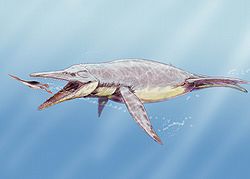  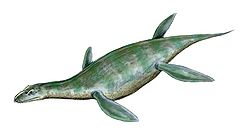 |
|
|
Paja Formation, Colombia | 8 meters long elasmosaurid | ||
|
Kronosaurus Kronosaurus is an extinct genus of short-necked pliosaur. It was among the largest pliosaurs, and is named after the leader of the Greek Titans, Cronus.-Discovery and species:Kronosaurus lived in the Early Cretaceous Period .... |
Aptian to Albian Albian The Albian is both an age of the geologic timescale and a stage in the stratigraphic column. It is the youngest or uppermost subdivision of the Early/Lower Cretaceous epoch/series. Its approximate time range is 112.0 ± 1.0 Ma to 99.6 ± 0.9 Ma... |
Boyaca Boyacá Department Boyacá is one of the 32 Departments of Colombia, and the remnant of one of the original nine states of the "United States of Colombia".Boyacá is centrally located within Colombia, almost entirely within the mountains of the Eastern Cordillera to the border with Venezuela, although the western end... , Colombia |
Among the largest pliosaurs, body-length estimates put the total length of Kronosaurus at 9–10 meters | |
|
Umoonasaurus Umoonasaurus is an extinct genus of plesiosaur belonging to the family Leptocleididae. This genus lived approximately 115 million years ago in shallow seas covering parts of what is now Australia. It was a relatively small animal around 2.5 m long... |
Australia | Relatively small cryptocleidid, around 2.5 m long, identified by the three crest-ridges on its skull. | ||
†Pterosaurs
- AnhangueraAnhangüeraAnhangüera originates from a word in the Tupi language which was the nickname given by Brazilian Indians to an explorer and "bandeirante", Bartolomeu Bueno da Silva .It may also refer to:* Anhanguera, Goiás, a municipality in the state of Goiás...
- Araripedactylus dehmi
- Araripesaurus castilhoi
- Arthurdactylus conandoylei
- Boreopterus cuiae
- BrasileodactylusBrasileodactylusBrasileodactylus is the name assigned to the remains of a pterosaur from the Lower Santana formation of the Aptian of Chapada do Araripe, Ceará, Brazil....
araripensis - Cearadactylus atrox
- Chaoyangopterus zhangi
- DsungaripterusDsungaripterusDsungaripterus was a genus of pterosaur, with an average wingspan of . It lived during the Early Cretaceous, in China, where the first fossil was found in the Junggar Basin.-Discovery and species:...
weii - DsungaripterusDsungaripterusDsungaripterus was a genus of pterosaur, with an average wingspan of . It lived during the Early Cretaceous, in China, where the first fossil was found in the Junggar Basin.-Discovery and species:...
brancai - Eoazhdarcho liaoxiensis
- Eopteranodon lii
- Gegepterus changi
- Haopterus gracilis
- Hongshanopterus lacustris
- Huaxiapterus benxiensis
- Huaxiapterus corollatus
- Huaxiapterus jii
- IstiodactylusIstiodactylusIstiodactylus was a medium sized pterosaur from the Early Cretaceous period.-History and species:In 1887 Harry Govier Seeley named the remains of a fossil pelvis discovered on the Isle of Wight, Ornithodesmus cluniculus, thinking it was a bird. In 1901 he considered that it might have been a...
latidens - IstiodactylusIstiodactylusIstiodactylus was a medium sized pterosaur from the Early Cretaceous period.-History and species:In 1887 Harry Govier Seeley named the remains of a fossil pelvis discovered on the Isle of Wight, Ornithodesmus cluniculus, thinking it was a bird. In 1901 he considered that it might have been a...
sinensis - Jidapterus edentus
- Liaoningopterus gui
- Liaoxipterus brachyognathus
- LonchodectesLonchodectesLonchodectes was a genus of pterosaur from several formations dating to the Turonian of England, mostly in the area around Kent...
- Longchengpterus zhaoi
- Ludodactylus sibbicki
- Nemicolopterus crypticus
- Nurhachius ignaciobritoi
- Ornithocheirus simusOrnithocheirusOrnithocheirus was a pterosaur from the Cretaceous period of Europe and South America...
- Ornithocheirus mesembrinusOrnithocheirusOrnithocheirus was a pterosaur from the Cretaceous period of Europe and South America...
- Pricesaurus megalodon
- SantanadactylusSantanadactylusSantanadactylus was a genus of pterodactyloid pterosaur from the Aptian-age Romualdo Member of the Lower Cretaceous Santana Formation, of Barra do Jardim, Araripe Plateau, Ceará Province, Brazil. Four species have been named, but today it is doubted they are part of the same genus...
- Sinopterus dongi
- Sinopterus gui
- Tapejara navigans
- Tapejara wellnhoferi
- Thalassodromeus sethiThalassodromeusThalassodromeus was a large pterodactyloid pterosaur found in northeastern Brazil.The genus was named in 2002 by Alexander Kellner and Diogenes de Almeida Campos. The type species is Thalassodromeus sethi. The genus name is derived from Greek thalasse, "sea" and dromaios, "runner", in reference to...
- Tropeognathus mesembrinus
- Tropeognathus robustus
- Tupandactylus imperator
†Sauropods
| †Sauropods Sauropoda Sauropoda , or the sauropods , are an infraorder of saurischian dinosaurs. They had long necks, long tails, small heads , and thick, pillar-like legs. They are notable for the enormous sizes attained by some species, and the group includes the largest animals to have ever lived on land... of the Aptian |
||||
|---|---|---|---|---|
| Taxa | Presence | Location | Description | Images |
|
Itapecuru Formation, Maranhão, Brazil | A genus of 12 meters long diplodocoid. |
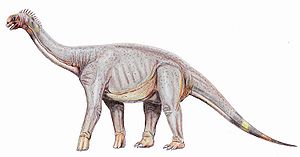 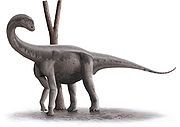  |
|
|
Arundel Formation, Maryland, USA | A large titanosaur, adults are estimated to have been more than 9m high and 15m to 18m long. | ||
|
Fusuisaurus Fusuisaurus is a genus of sauropod dinosaur from the Early Cretaceous of China.... |
Napai Formation, Guangxi, China | Probably a basal titanosaur, known by fragmentary postcranial remains | ||
|
Jobaria Jobaria was a sauropod dinosaur discovered in the Sahara Desert in 1997. It was named after "Jobar", a creature of local legends, and is thought to have been about 18 metres long. It was found in the Tiourarén Formation, originally thought to represent the Hauterivian to Barremian stages of the... |
Aptian or Albian Albian The Albian is both an age of the geologic timescale and a stage in the stratigraphic column. It is the youngest or uppermost subdivision of the Early/Lower Cretaceous epoch/series. Its approximate time range is 112.0 ± 1.0 Ma to 99.6 ± 0.9 Ma... |
Sahara Desert | Seems to be a very primitive sauropod. Unlike other Cretaceous sauropods, Jobaria had spoon-shaped teeth. | |
|
Karongasaurus Karongasaurus is the name given to a genus of dinosaur from the Early Cretaceous. It was a titanosaurid sauropod. Its fossils, consisting solely of part of a lower mandible and a few teeth, were found in Malawi... |
Malawi | Titanosaurid which fossils consist solely of parts of a lower mandible and a few teeth | ||
|
Ligabuesaurus Ligabuesaurus is a genus of dinosaur from the Early Cretaceous . It was a basal titanosaurid sauropod which lived in what is now Argentina. The type species, Ligabuesaurus leanzai, was described by Jose Bonaparte, Gonzalez Riga, and Sebastián Apesteguía in 2006, based on a partial skeleton... |
Argentina | A basal titanosaurid | ||
|
Malawisaurus Malawisaurus was a genus of sauropod dinosaur . It lived in what is now Africa, specifically Malawi, during the Aptian age of the Early Cretaceous Period. It is one of the few titanosaurs for which skull material has been found.It was named by Louis L. Jacobs and colleagues, and was originally... |
Malawi | One of the few titanosaurs for which skull material has been found | ||
|
Nigersaurus Nigersaurus is a genus of diplodocoid sauropod dinosaur from the middle Cretaceous period, about 119 to 99 million years ago during the Aptian or Albian age. This dinosaur was described by Paul Sereno and colleagues in 1999... |
Elrhaz Formation Elrhaz Formation The Elrhaz Formation is a geological formation in Niger whose strata date back to the Early Cretaceous... , Niger |
Diplodocoid dinosaur, one of the most common genera found in the rich fossil vertebrate fauna of the Elrhaz Formation | ||
|
Paluxysaurus Paluxysaurus is a genus of basal titanosauriform sauropod dinosaur from the late Aptian or early Albian-age Lower Cretaceous Twin Mountains Formation of Hood County, Texas, USA... |
Twin Mountains Formation Twin Mountains Formation The Twin Mountains Formation, also known as the Twin Mountain Formation, is a sedimentary rock formation, within the Trinity Group, found in Texas of the United States of America. It is a terrestrial formation of Aptian age , and is notable for its dinosaur fossils... , Texas, USA |
A basal titanosauriform | ||
|
Sauroposeidon Sauroposeidon is a genus of sauropod dinosaur known from four neck vertebrae that were found in the southeastern portion of the US state of Oklahoma. The fossils were found in rocks dating to the Early Cretaceous, a period when the sauropods of North America had diminished in both size and... |
Antlers Formation Antlers Formation The Antlers Formation occurs as a band of strata from Arkansas through southern Oklahoma into northeastern Texas. It consists of 150 m of silty to sandy mudstones, fine- to coarse grained sandstones that are poorly to moderately sorted and cemented with clay or calcium carbonate... , Oklahoma, USA |
The last known giant brachiosaurid; extrapolations indicate that the head of Sauroposeidon could reach 17 m in height, making it the tallest known dinosaur. With an estimated length of 30 m and a mass of 36–40 MT it also ranks among the longest and heaviest. | ||
|
Tangvayosaurus Tangvayosaurus is a genus of sauropod dinosaur from the Aptian-Albian age Lower Cretaceous Grès Supérior Formation of Savannakhet, Laos... |
Grès Supérior Formation, Laos | A basal titanosaur, known from the remains of two or three individuals. | ||
|
Venenosaurus Venenosaurus named after the Poison Strip Member of the Cedar Mountain Formation in Utah, where the fossils were discovered by a Denver Museum of Natural History volunteer Tony DiCroce in 1998. Venenosaurus dicrocei was first described as a new species in 2001 by Virginia Tidwell, Kenneth... |
Cedar Mountain Formation Cedar Mountain Formation The Cedar Mountain Formation is the name given to distinctive sedimentary rocks in eastern Utah that occur between the underlying Morrison Formation and overlying Naturita Formation . It is composed of non-marine sediments, that is, sediments deposited in rivers, lakes and on flood plains... , Utah, USA |
A titanosaur, known from an incomplete skeleton of an adult and a juvenile | ||
†Stegosaurs
| †Stegosauria Stegosauria Known colloquially as stegosaurs, the Stegosauria are a group of herbivorous dinosaurs of the Jurassic and Early Cretaceous Periods, being found mostly in the Northern Hemisphere, predominantly in what is now North America and China.... of the Aptian |
||||
|---|---|---|---|---|
| Taxa | Presence | Location | Description | Images |
|
Xinjiang, Inner Mongolia, China | 7 meter long stegosaurid |
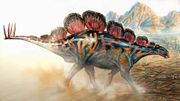 |
|
†Non Avian Theropods
| †Non Avian Theropods of the Aptian | ||||
|---|---|---|---|---|
| Taxa | Presence | Location | Description | Images |
|
Texas, Oklahoma, ?Maryland, USA | Likely an apex predator, up to 12 meters long. Classification disputed (Carcharodontosaurid or Allosaurid) |
     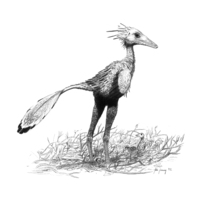 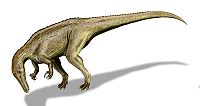  |
|
|
Jiufotang Formation Jiufotang Formation The Jiufotang Formation is an Early Cretaceous geological formation in Chaoyang, Liaoning which has yielded fossils of feathered dinosaurs, primitive birds, pterosaurs, and other organisms. . It is a member of the Jehol group. The exact age of the Jiufotang has been debated for years, with... , Liaoning, China |
Small (90 centimeters long feathered dromeaosaurid, possibly the same species as Microraptor Microraptor Microraptor is a genus of small, four-winged dromaeosaurid dinosaurs. Numerous well-preserved fossil specimens have been recovered from Liaoning, China... |
||
|
Deinonychus Deinonychus was a genus of carnivorous dromaeosaurid dinosaur. There is one described species, Deinonychus antirrhopus. This 3.4 meter long dinosaur lived during the early Cretaceous Period, about 115–108 million years ago . Fossils have been recovered from the U.S... |
Cloverly Formation Cloverly Formation The Cloverly Formation are Lower Cretaceous strata located in Montana and Wyoming, in the western United States. The term now includes strata that had formerly been called the Dakota Formation in central and southern Wyoming.-Members:... , Montana and Wyoming, Antlers Formation Antlers Formation The Antlers Formation occurs as a band of strata from Arkansas through southern Oklahoma into northeastern Texas. It consists of 150 m of silty to sandy mudstones, fine- to coarse grained sandstones that are poorly to moderately sorted and cemented with clay or calcium carbonate... , Oklahoma, Potomac Formation Potomac Formation The Potomac Formation consists of Lower Cretaceous to Upper Cretaceous strata located in Delaware, Maryland, and New Jersey, in the eastern United States.Flora found include large cycads.... , Maryland, USA |
3-4 meters long carnivorous dromaeosaurid | ||
|
Genyodectes Genyodectes is a genus of ceratosaurian theropod dinosaur from the Lower Cretaceous of South America. The holotype material was collected from the Cañadón Grande, Departamento Paso de Indios in the Chubut Province of Argentina and consists of an incomplete snout, including the premaxillae,... |
Chubut Province, Argentina | Possibly ceratosaurian | ||
|
Huaxiagnathus Huaxiagnathus is a genus of theropod dinosaur from the Lower Cretaceous of China. It was a compsognathid, large for that group at about half a meter longer than Compsognathus and larger specimens of Sinosauropteryx, with the largest specimen about 1.8 meters in length.The name Huaxiagnathus is... |
Yixian Formation Yixian Formation The Yixian Formation is a geological formation in Jinzhou, Liaoning, People's Republic of China, that spans 11 million years during the early Cretaceous period... , Liaoning, China |
Large (1.8 meter long) compsognathid | ||
|
Kryptops Kryptops is a genus of abelisaurid theropod dinosaur from the Early Cretaceous of Niger. It is known from a partial skeleton found at the Gadoufaoua locality in the western Ténéré Desert, in rocks of the Aptian-Albian age Elrhaz Formation... |
Elrhaz Formation Elrhaz Formation The Elrhaz Formation is a geological formation in Niger whose strata date back to the Early Cretaceous... , Niger |
Earliest-known abelisaurid | ||
|
Neovenator Neovenator is a genus of allosauroid dinosaur. Since its discovery on the Isle of Wight, UK, it has become one of the best-known large carnivorous dinosaurs in Europe. Neovenator was at first considered possibly a new species of Megalosaurus. It measured approximately 7.5 meters in length,... |
Isle of Wight, England, UK | 7.5 meters long allosaurid | ||
|
Protarchaeopteryx Protarchaeopteryx is a genus of turkey-sized feathered theropod dinosaur from China. Known from the Jianshangou bed of the Yixian Formation, it lived during the early Aptian age of the Early Cretaceous, approximately 124.6 million years ago... |
Yixian Formation Yixian Formation The Yixian Formation is a geological formation in Jinzhou, Liaoning, People's Republic of China, that spans 11 million years during the early Cretaceous period... , Liaoning, China |
Primitive oviraptosaur, possibly synonymous with Incisivosaurus Incisivosaurus Incisivosaurus is a genus of small, probably herbivorous theropod dinosaur from the early Cretaceous Period of what is now the People's Republic of China... |
||
|
Similicaudipteryx Similicaudipteryx, meaning "similar to Caudipteryx" , is a genus of theropod dinosaur of the family Caudipteridae. Its fossil remains were recovered from the Jiufotang and Yixian Formations of northeastern China, dating to the early Cretaceous Period between 124 and 120 million years ago... |
Jiufotang Formation Jiufotang Formation The Jiufotang Formation is an Early Cretaceous geological formation in Chaoyang, Liaoning which has yielded fossils of feathered dinosaurs, primitive birds, pterosaurs, and other organisms. . It is a member of the Jehol group. The exact age of the Jiufotang has been debated for years, with... , Liaoning, China |
Caudipterid oviraptosaur | ||
|
Sinornithoides Sinornithoides is a genus of troodontid theropod dinosaur. It lived during the Early Cretaceous . It measured approximately 1 meter long... |
China | 1 meter long troodontid | ||
|
Sinosauropteryx Sinosauropteryx was the first genus of dinosaur outside of Avialae to be found with evidence of feathers. They were covered with "furry" coats of very simple filament-like feathers... |
Liaoning, China | 1.20 meter long compsognathid, fossilized with traces of color pigmentation in its feathers | ||
|
Suchomimus Suchomimus is a genus of large spinosaurid dinosaur with a crocodile-like mouth that lived sometime between 121-112 million years ago, during the late Aptian stage of the Cretaceous period in Africa.-Description:... |
Tenere, Niger | 12 meters long spinosaurid | ||
|
Tyrannotitan Tyrannotitan is a genus of huge bipedal carnivorous dinosaur of the carcharodontosaurid family from the Aptian stage of the early Cretaceous period, discovered in Argentina. It is closely related to other giant predators like Giganotosaurus and Carcharodontosaurus... |
Chubut Province, Argentina | 12 meters long carcharodontosaurid | ||
|
Utahraptor Utahraptor is a genus of theropod dinosaurs, including the largest known members of the family Dromaeosauridae. Fossil specimens date to the upper Barremian stage of the early Cretaceous period... |
North America | The largest known dromaeosaurid | ||
Literature
; 2004: A Geologic Time Scale 2004, Cambridge University PressCambridge University Press
Cambridge University Press is the publishing business of the University of Cambridge. Granted letters patent by Henry VIII in 1534, it is the world's oldest publishing house, and the second largest university press in the world...
.; 1842: Paléontologie française: Terrains crétacés, vol. ii.
External links
- GeoWhen Database - Aptian
- Mid-Cretaceous timescale, at the website of the subcommission for stratigraphic information of the ICS
- Stratigraphic charts of the Lower Cretaceous: http://norges.uio.no/timescale/Fig18.1_Cret_colB.pdf and http://norges.uio.no/timescale/Fig18.1_Cret_colC.pdf, at the website of Norges Network of offshore records of geology and stratigraphy

